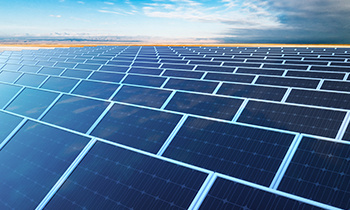Core Views on Photovoltaic Silver Paste
[Summary Description] The amount of silver paste used per battery unit has decreased, but driven by the rapid development of the photovoltaic industry and the promotion of N-type photovoltaic cells, which has increased the demand for silver paste, the growth of China's photovoltaic silver paste demand is certain. Photovoltaic silver paste technology is advancing rapidly and has certain customization characteristics, resulting in a high barrier to entry. Domestic substitution continues to advance, and the prospects for domestic substitution are promising. We believe that leading photovoltaic silver paste companies have advantages in technology and customers, and have obvious first-mover advantages, and will benefit from the rapid development of the industry in the future.
Photovoltaic silver paste is an important auxiliary material for photovoltaic cells.
Photovoltaic silver paste is a mixture composed of high-purity silver powder as the conductive phase, glass oxide as the binder phase, and an organic carrier. After mixing and three-roll milling, it forms a uniform paste. The photovoltaic silver paste is applied to the photovoltaic cell through screen printing, and after drying and sintering, it forms the metal electrode of the photovoltaic cell, which can collect and conduct the surface current of the photovoltaic cell. Photovoltaic conductive silver paste is the most important auxiliary material for photovoltaic cells and directly affects the cell's photoelectric conversion efficiency. In photovoltaic cells, silver paste is the second most expensive material after silicon wafers, accounting for approximately 10% of the cost of photovoltaic cells.
Demand for photovoltaic silver paste is growing, while the amount of silver paste used per unit of various types of photovoltaic cells is decreasing.
In 2020, the global and Chinese consumption of photovoltaic silver paste was 2990 tons and 2467 tons, respectively. The compound annual growth rate from 2016 to 2020 was 6.4% and 11.7%, respectively. Due to its high cost, the photovoltaic industry is working to reduce the amount of photovoltaic silver paste used per cell. In the future, the amount of silver paste used per unit cell of various types of cells will continue to decrease. On the other hand, with its higher photoelectric conversion efficiency, the market share of N-type photovoltaic cells is expected to gradually increase. N-type cells are double-sided cells, and the amount of silver paste used per cell is significantly higher than that of the currently mainstream P-type cells, which is conducive to increasing the demand for silver paste. We believe that although the unit consumption of silver paste for various photovoltaic cells will decrease in the future, with the rapid development of the photovoltaic industry and the increase in the proportion of N-type cells, the global and domestic demand for photovoltaic silver paste will increase rapidly. Global silver paste demand will increase from 2990 tons in 2020 to 5607 tons in 2025, with a compound annual growth rate of approximately 13%, while China's photovoltaic silver paste demand (excluding the consumption of exported battery silver paste) will increase from 1109 tons in 2020 to 1869 tons in 2025, with a compound annual growth rate of approximately 11%.
Photovoltaic silver paste production has a high barrier to entry, and domestic production is in full swing.
Photovoltaic silver paste requires adjustments to its formula and production process to adapt to downstream technological iterations and customer needs, and has certain customization characteristics. In the production process, in addition to the high requirements for raw material quality and selection, the paste's formulation, manufacturing process, and mass production stability require long-term research and development, continuous optimization, and a high barrier to entry. With technological progress, relying on localization and cost advantages, the trend of import substitution of China's photovoltaic silver paste is obvious. The domestic production rate of front photovoltaic silver paste has increased significantly from about 5% in 2015 to 50% in 2020, with companies such as Polyking, Dico and Jingying New Materials emerging. It is expected that the domestication process of China's photovoltaic silver paste will continue in the future.
Previous: Photovoltaic is the trend of the future
Next: Photovoltaic Equipment Industry Research and 2022 Annual Strategy: Fully Embrace New Technologies
RELATED INFORMATION
The 392.4 kW grid-connected power generation project at the PetroChina Guangdong Zengcheng Fenggang gas station by Meijidian Energy Photovoltaic has been successfully completed.
On the morning of May 30, a group of four from the Zengcheng Power Supply Bureau of the Southern Power Grid arrived at the Fenggang Sinopec gas station to connect the photovoltaic power generation system to the grid. After two hours of orderly work by the power supply bureau and photovoltaic installation technicians, the original power line was removed and the photovoltaic power line was connected. The photovoltaic meter began to show readings, marking the successful grid connection of the power station for self-generation and surplus power transmission to the grid. It is expected to generate 76125.6 kWh of electricity annually, saving 18.3 tons of standard coal and reducing carbon dioxide emissions by 47.66 tons and sulfur dioxide emissions by 1.18 tons.
General Manager Zhang, Vice Chairman and Chief Economist of CGN Group, and Wu Shaohua, Secretary of the Party Committee of China Railway Group Limited, visited Meji Electric Energy Company to guide its work!
On the morning of May 9th, Mr. Zhang, Vice Chairman and Chief Economist of CGN Group, Mr. Wu Shaohua, Party Secretary of China Railway Group Limited, and Mr. Xiao, Chairman of Meijidian Energy Photovoltaic New Energy Investment, visited our company for guidance.
Li Keqiang: Promote the construction of large-scale wind and photovoltaic bases, and exclude renewable energy and raw material energy consumption from the total energy consumption control.
The fifth session of the 13th National People's Congress (NPC) opened at the Great Hall of the People at 9 a.m. on Saturday, March 5, 2022. Premier Li Keqiang delivered the Government Work Report on behalf of the State Council to the fifth session of the 13th NPC.
Support coal, oil and gas companies in building photovoltaic power plants to promote the accelerated development of new energy from multiple perspectives
Develop new energy, distributed energy, and new energy storage














